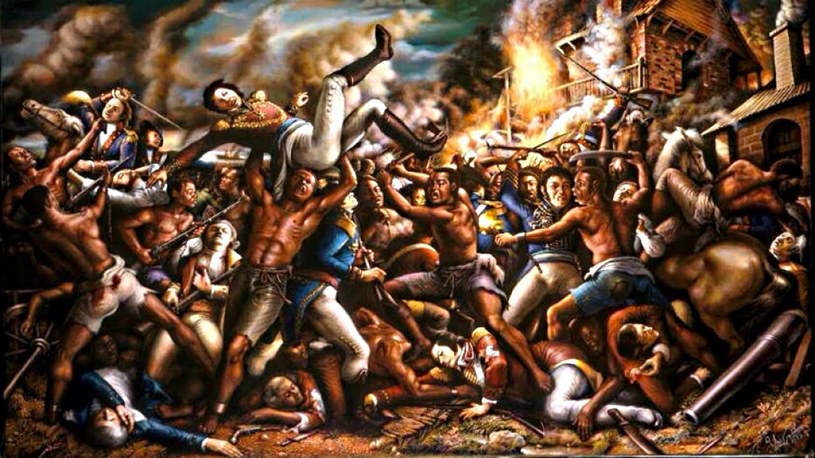After a period of distraction I seemed to have found my mojo again.... hurray.... in recent months things have been a little quiet but a trip to Partizan has light the fires and a new project is up and runing....
I fancied changing conflicts but still utilising much of the terrain I already have, in true form nothing to ordinary so why not the Haitian Revolution!
I have had my eye on this for quite a while after playing in Nick's Skinners excellent Sharp Practice in last years Lardy Day coupled with a recent visit to the Liverpool Slavery Museum.
http://www.liverpoolmuseums.org.uk/ism/collections
The period offers so much for the Sharp Practice gamer, the forces are small in comparison to most Napoleonic encounters and the opportunity for various scenario's what with the constantly changing alliances.
Considering the popularity of
Napoleonics, the ranges are some what limited so to is any illistrated history and with a number of the club owning British and French, I figured I would start with the Haitian Revolutionaries - Brilliant even less information available.... Hhhmm.
Osprey's Napoleon’s Overseas Army was a useful guide and with Trent Miniatures and the odd pirate figure from foundry thrown in I would have enough options to pull together a couple of bands of
former
slaves for starters.
For those of you who are not familar with the conflict Haiti
or Saint Domingue as it was called by the French was a valuable French
Colony exporting sugar to Western Europe controlled largely by French
plantation owners as the French Revolution broke out in mainland France so to the spirit of revolution spread to Haiti.
The conflict itself can be spread over several phases.
The conflict itself can be spread over several phases.
It was the French Revolution which lead to
the rise of the Haitian independence movement starting out with a rebellion of slaves, which eventually mobilized all levels of society in Haiti including free men of colour (mulattos), a number of which were Plantation owners in their own right many others outlaw slaves living in the mountains known as maroons.
These two groups played a major part in the early rebellions of
1790-1792, leading up to a 1792 decree which made free men of colour legal citizens.

Czytaj więcej na http://facet.interia.pl/historia/news-nasi-na-karaibach-zagadka-niebieskookich-mulatow,nId,2339286#utm_source=paste&utm_medium=paste&utm_campaign=firefox
What really appeals is that many of the encounters of the Haitian Revolution was fought sporadically often in isolated
conflicts. There was significant infighting especially between the
predominantly slave and former slave militias, and the private armies
& regiments' of the mulatto generals, most notably André Rigaud.
Rigaud was a well known noble, a veteran of the French mission to
America during the American Revolution he controlled close to 7,000
soldiers in south of Haiti before emancipation as a dictator-general his personal
rivalry with General Toussaint Louverture led Haiti into the first
rebellion - The War of Knives (1799-1800)
Haiti as first a semi-independent became important in the now global conflict between Britain and France in the Napoleonic Wars
It's Leader Toussaint Louverture courted trade and diplomatic treaties with the US and Britain yet remained outwardly loyal to France. Pushing matters to far he triggered a change in policy in France and Napoleon who ordered an invasion force led by Victor-Emmanuel Leclerc to
invade Haiti and take back control the island from the upstart rebels.
Arriving in the port of Cap-Français (Cap-Haïtien)
the capital of Saint Domingue at the time. Haitian patriot and future
president & King Henri Christophe burned the city rather than let
the French take it by arms before siding with the French.
The Haitians retreated with both
Toussaint and Christophe surrendering to General Leclerc’s forces, with
eventually Christophe and Jean-Jacques Dessalines working with the
French as officers in their army.
The
Island and climate was the greatest threat the to invading French and
Leclerc and many of forces died of fever. Sensing a French weakness many
of the Haitian generals including Christophe
changed sides yet again.

Eventually the Haitians secured victory over Napoleon & General
Rochambeau, winning independence in 1804 through the decisive Battle of Vertieres which lead to French withdraw under pressure in Europe.

Many of the units and combatants can be used for various sides in the conflict and with the option to include French, British and Spanish units which will make for some great scenario's in multi-player battles. Much of my jungle terrain can be pressed into service which leaves me to concentrate on the figures.
Plenty to get my teeth into in the coming weeks lets see what progress can be made this bank holiday weekend.



Fascination post Stuart. I was only vaguely aware of the conflict through the miniatures so really interested to see how it plays; certainly looks like it is going to be a very evocative period to game. Best of luck Sir.
ReplyDeleteThanks Michael it's certainly got the juices flowing again.
DeleteCheers
Stu
Stuart,
ReplyDeleteYou have chosen a very interesting theater to game...with Napoleonic and Native figures to paint and using your existing terrain - you are certainly on a winner!
Look forward to developments with your NEW Project. Cheers. KEV.
Thanks Kev, I do like to ensure my terrain is multi-purpose besides I am running out of room and may have to face moving some of the pieces on.
DeleteCheers
Stu
Something certainly left field and looking forward to seeing how this develops.
ReplyDeleteThe butterfly strikes agian Steve.
Delete